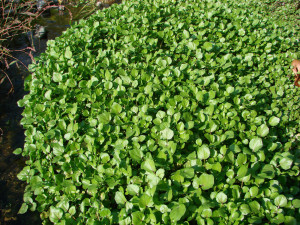- Watercress is related to the flowers that grow in many British gardens, nasturtiums. Nasturtium comes from the Latin, nasusmeaning nose and torquere, to torment. The nasturtium family of cresses (which includes the flower and the herb called Garden cress) has a pungent aroma, which explains their name. Watercress grows wild in Britain by clear flowing streams, and I used to gather it on the mountain, when I was a child. I have always loved both the smell and the taste of this herb. Now of course it is cultivated and can easily be bought from supermarket shelves, but you can also grow your own by putting some leaves with stems in a bottle of water and changing it once a day. When it has grown roots it can be transplanted into pots of sandy soil and watered frequently.
- Watercress is native to Europe and Russia, but now grows on most continents. The Greeks and Romans believed that it cleared the mind so that decisions could be made more easily. They used it as a salve for wounds. If you rub a paste of the leaves onto a wound it will stop any infection as the leaves have antiviral and anti-bacterial properties.
- It is good eaten raw in salads and is useful for diabetics as it helps get rid of excess sugar in the blood. It is a diuretic and so good for obesity as it helps the body rid itself of excess water. It cannot help remove stones from the internal organs but it a good preventative. Watercress aids the liver, helping it to stay healthy.
- Watercress belongs to the Brassica family of vegetables along with broccoli and brussel sprouts and shares many of the same properties. It tastes a little like rocket but is less spicy, although they can be substituted for each other.
- A tisane can be made from 5 gr. of watercress to 1 cup of boiling water, steeped for 10 minutes and then strained. This is good as a diuretic and if you have a bronchial cough or cold. You can also steep 25 gr of watercress in a glass of cold water overnight and strain it in the morning and take a tablespoon 4 times a day. Pep it up with the addition of cayenne pepper or black pepper.
- If you crush the leaves to get the juice from them you can apply this to your face to remove any skin blemishes, but to get rid of pimples you should take the tisane internally.
- Watercress can help with respiratory illnesses as it is an expectorant, antibronchitic, antiviral, antipyretic and a general tonic. It contains 13 amino acids, theB-complex vitamins, vitamins A, C, and the following minerals: – calcium, copper, iron, magnesium, manganese, phosphorous, potassium, sodium, iodine and zinc. This means that it contains a lot of antioxidants, so helps with blood flow, etc. It also contains beta-carotene, fibre, and essential oil, glutotropeolin, and glycosides.
Source: http://herbs-treatandtaste.blogspot.com/2010/12/watercress-nasturtium-officinale.html

